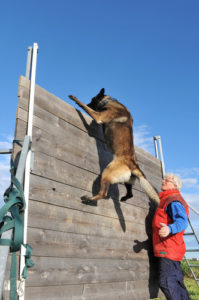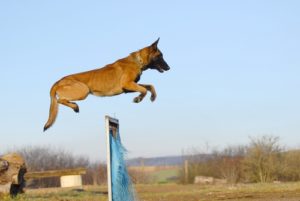 It’s fast, intense, and very difficult. It has moments of ease and times you’ll be at the end of your seat. It takes a dedicated dog, bred for the work necessary for the sport, and an even more dedicated handler. It brings together working dog enthusiasts and new owners looking for exciting new adventures with their dogs. It’s French Ring Sport.
It’s fast, intense, and very difficult. It has moments of ease and times you’ll be at the end of your seat. It takes a dedicated dog, bred for the work necessary for the sport, and an even more dedicated handler. It brings together working dog enthusiasts and new owners looking for exciting new adventures with their dogs. It’s French Ring Sport.
Related: Best Dog Training Courses You Can In The Comfort of Your Home
As its title suggests, French Ring is a protection dog sport based out of France. It includes various exercises in both obedience and protection. It consists of an initial temperament test that shows the dog has the correct mind and body to work through the rest of the sport. After this test, called the CSAU, or Certificat de Sociabilité et d’Aptitude à l’Utilisation (Certificate of Sociability and Aptitude for Work), a Brevet must be done before advancing to the sports three levels: French Ring 1, 2, and 3. As with most sports, the higher the level, the more difficult they are to pass.
The Brevet consists of a 15-minute routine that includes some basic obedience and protection exercises. Levels 1-3 are longer and include more difficult exercises both in obedience and protection. You’re probably familiar with obedience, including heeling and agility jumps. However, in French Ring, obedience exercises also entail refusal of thrown food with the handler out of sight, changes of positions (sit, down, stand) with the handler at a distance, and broad jumps and palisades. The obedience in French Ring typically requires a more physically fit dog than does a regular obedience routine. Even with difficult exercises, obedience can be accomplished by most dogs. It’s the protection however, that requires special skill.
In a nutshell, French Ring consists of a handler and dog team and an aggressor known as a decoy. This decoy is a person wearing a protective body suit called a bite suit. These bite suits keep the decoy safe when the dogs are sent to attack him. The purpose of French Ring is to test a dog’s suitability for guarding and protection work. Almost all military and working K9’s have been trained and sent to bite a bad guy wearing a bite suit. The dogs trained in French Ring (as well as other protection sports) and used in real-life scenarios come from years of selective breeding to ensure that we have dogs that are capable of being useful in these demanding positions.
The protection phases consist of a number of different exercises for the handler/dog team to work through. In one instance, there is the defense of handler. In this case, the dog walks with the handler while keeping a steady eye on the decoy. When the decoy strikes the handler, the dog bites. The dogs must out on command and guard him by barking. In some cases, the dog is sent to attack but then called off and, before biting, return back to the handler. As you can imagine, this is not an easy task to accomplish. In another scenario, the dog must bite the decoy while he shoots a pistol (containing blanks) and show courage against the gunfire. Perhaps one of the most iconic routines is the object guard, in which a dog is left in the field with the handler out of sight. He must guard an object (typically a basket), from a decoy that is trying to steal it. The dog must be trained to bite the decoy only when he comes within one meter of the object, and out on his own (without the handler’s command) once the decoy retreats, so he can return to the object and guard it.
 These are all some of the parts that make up the levels in the sport. The exercises are scored on a point basis, and the teams need to accumulate a certain number for them to pass that routine. The Brevet and Levels 1-3 contain 100, 200, 300, and 400 points respectively. Each team must have two passing scores under two different routines (called “legs”) in order to move on to the next level. For example, for a team to move from Ring 1 to Ring 2, they must pass Ring 1 twice with a score of 160/200 or better each time. Without excellent training and commitment for both the obedience and protection, the points can fall off very quickly.
These are all some of the parts that make up the levels in the sport. The exercises are scored on a point basis, and the teams need to accumulate a certain number for them to pass that routine. The Brevet and Levels 1-3 contain 100, 200, 300, and 400 points respectively. Each team must have two passing scores under two different routines (called “legs”) in order to move on to the next level. For example, for a team to move from Ring 1 to Ring 2, they must pass Ring 1 twice with a score of 160/200 or better each time. Without excellent training and commitment for both the obedience and protection, the points can fall off very quickly.
French Ring Sport is exciting and challenging for both dog and handler, and it strives to showcase the best of the working dogs in their category. Because it focuses on protection dogs and their ability for work, the most common breeds you’ll see competing are Belgian Malinois, Dutch Shepherds, and German Shepherd Dogs; although Rottweilers, Dobermans, and American Bulldogs have done well. It is a sport for the serious trainer, but most clubs and members are very welcoming to newcomers who want to start out in something as exciting as French Ring. There are plenty of videos to watch online, and finding a club is relatively easy. In North America, you can find a club or even attend a trial near you by contacting NARA, the North American Ring Association. French Ring is a wonderful sport that both dog and people have come to enjoy. It takes a lot of time and dedication for these handlers to accomplish what they work so hard to do. Even if you don’t think you’re ready to get out there and compete, you can bring a chair, socialize, and enjoy the show. They may be serious, but they are, after all, just dog lovers who love their dogs.
About the Author
Katie is a professional dog trainer located in Southern California, with a background of experience as a veterinary assistant as well. She has trained and competed with multiple breeds in AKC Obedience and Rally, agility, herding, Schutzhund/IPO, French Ring and conformation. She has been involved in dogs since she was a child, and specializes in protection dogs, working dogs, and aggression issues. You can visit her website, Katie’s Dog Training, to find out more information about her training and accomplishments. When she’s not helping others and writing, she’s out on the field with her Belgian Malinois and Pembroke Welsh Corgi.
 Toledo, United States.
Toledo, United States.